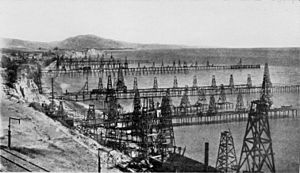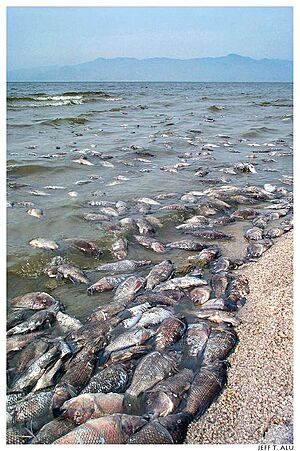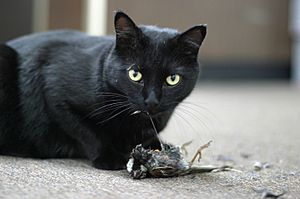Environment of California facts for kids
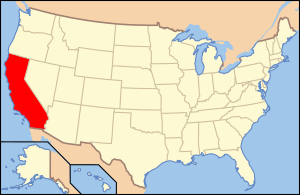
The environment of California is all about how people have changed and shaped the natural world in the state of California. It covers everything from how we use land and water to how our cities affect plants and animals.
Contents
California's Environmental Story
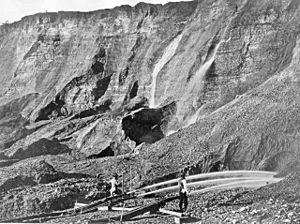
California has a Mediterranean climate. This means it has dry summers. This dry weather makes plants easy to catch fire, causing wildfires.
Long ago, Native Californians used fire to control brush. They also used it to help grow plants for food. These regular fires kept forests open. But in the 1900s, laws stopped this burning to protect buildings.
European settlers brought new crops and animals. This happened with missions along the coast. The California Gold Rush then brought many new people. San Francisco became a big city very quickly.
Soon, water became very important for growth. Early laws set up water rights for farming and hydraulic mining. Hydraulic mining used strong water jets to dig for gold.
The Great Flood of 1862 caused big problems. Gravel from gold mining washed into rivers. This covered farmland and filled up river channels. These channels were once used for boats. This damage led to laws to control water pollution. These laws even covered materials like gravel. California's early laws helped create the United States Environmental Protection Agency's National Pollutant Discharge Elimination System.
People and Travel in California
Before Europeans arrived, about 300,000 Native Californians lived in the state. They lived in groups that found their own food. They lived near rivers and coastal wetlands.
Early European trade happened by ship. But a road called El Camino Real also linked missions. It went from Mexico up the coast to San Francisco Bay. San Francisco Bay became a key port during the Gold Rush. Ferries carried goods between the port and mining areas.
The California Trail was the first important land route. It connected San Francisco Bay to the eastern United States. This trail became the path for the First transcontinental railroad in 1869. The Gold Rush brought about 200,000 new people. By 1870, 36% of Californians lived near San Francisco Bay.
Lumber from redwood forests went to San Francisco by ship. Redwood was not good for railroad ties. So, fast-growing Australian eucalyptus trees were planted.
Railroads grew, connecting San Francisco Bay north and south. In 1885, a new railroad linked Los Angeles and San Diego to the rest of the country. Shipping citrus fruit by train began in 1890.
Oil was found in 1892. The first offshore drilling happened in 1896 at Summerland Oil Field. Hollywood's film industry also grew. The United States Navy moved its main fleet to San Pedro in 1919. These events helped southern coastal cities grow fast. By 1920, 36% of the state's people lived there.
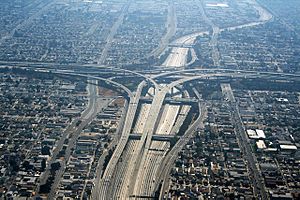
As California's oil production peaked, new roads were built. The United States Highway System started in 1925. U.S. Route 101 followed El Camino Real. U.S. Route 99 went north from Los Angeles through the Central Valley. The Lincoln Highway and U.S. Route 66 followed the transcontinental rail routes.
Cars became very popular. This led to building more roads. California Route 1 connected California State Beaches. U.S. Route 395 went through the Sierra Nevada. The Arroyo Seco Parkway was California's first freeway.
In 1954, Smog became a clear air pollution problem. This happened as public transport systems were removed. By 1959, 51% of Californians lived in southern coastal cities. The Interstate Highway System arrived. Interstate 80 replaced Lincoln Highway. Interstate 40 replaced Route 66. Interstate 5 went from San Diego through Los Angeles and north.
Today, modern train services include Bay Area Rapid Transit and Los Angeles Metro Rail. In 2010, 9 million Californians lived near San Francisco Bay. And 21 million lived in the southern coastal cities.
Moving Water Around California
People who didn't find gold saw California's farming potential. They started changing rivers to grow more food. Lakes like Mono Lake and Tulare Lake got smaller. Their water was sent to farms. Little Lake was drained in 1874 to create the town of Willits, California.
The Klamath Project in 1905 drained large, shallow lakes. This turned them into farmland. The Potter Valley Project in 1906 moved water from the Eel River to the Russian River. This provided electricity. Lake Pillsbury was formed in 1922 to help irrigate Potter Valley.
The California Water Wars began with the Los Angeles Aqueduct in 1913. This was the first big project to move water from northern mountains. It met the needs of southern California's growing cities. The Hetch Hetchy Aqueduct brought water to San Francisco in 1932. This happened despite John Muir's efforts to save Yosemite National Park's Hetch Hetchy Valley. The Colorado River Compact in 1922 allowed the Colorado River Aqueduct to reach Los Angeles in 1941.
The U.S. Bureau of Reclamation built public projects. These included Friant Dam on the San Joaquin River in 1942. Shasta Dam on the Sacramento River followed in 1945. These dams helped control winter floods. They also reduced salt in the Sacramento-San Joaquin Delta in summer. This helped farming on drained wetlands.
The Central Valley Project continued with more dams. These were Folsom Dam on the American River, Trinity Dam on the Trinity River, and Oroville Dam on the Feather River. The California Aqueduct was built to Southern California. A Peripheral Canal might help restore the delta's natural salt levels.
Much of the water sent to southern California is used for farming. Water that flows back from irrigation, like the New River, can have pesticides and minerals. This water can collect in basins like Kesterson Reservoir. The Salton Sea grew larger because of water diverted from the Colorado River.
New Homes for Animals

Beyond farms, water transfers have created unique city environments in southern California. Cities here are spread out. This is because people use cars. These areas have many different plants for landscaping.
Animals that eat many kinds of food can cross streets and freeways. They do well in these spread-out areas. They find water from garden sprinklers in dry seasons. Birds like pigeons, crows, house sparrows, European starlings, and gulls fly between green spaces. Animals like raccoons, opossums, skunks, and rats travel under bridges and through storm drains.
Animals killed trying to cross roads become food for scavengers. These scavengers also look for garbage or food left for pets or wild birds and squirrels. Pet cats and dogs sometimes hunt small animals. This has led to wild populations of these predators. Coyotes then hunt these smaller predators.
Environmental Laws
- California Environmental Quality Act
- California Proposition 23
- California Proposition 50 (2002)
- California Proposition 65 (1986)
- Electronic Waste Recycling Act
- Electronic Waste Recycling Fee
Environmental Groups
- California Air Resources Board
- California Coastal Commission
- California Coastal Conservancy
- California Department of Pesticide Regulation
- California Department of Toxic Substances Control
- California Environmental Protection Agency
- California State Lands Commission
- Water Education Foundation
Climate Change


